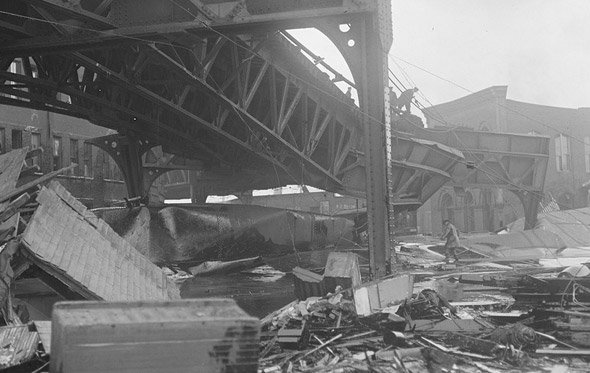
Among other things, the Great Molasses Flood took out the elevated subway tracks that ran over Commercial Street, as shown in this photo by news photographer Leslie Jones.
At 12:30 p.m., take a moment to remember the 21 people killed by a gooey, bittersweet flood of more than 2 million gallons of molasses, just moments after the machine-gun-like sound of rivets giving way echoed across the North End and the tank burst on an unseasonably warm January day in 1919, thanks to shoddy construction by the tank's owner.
Dark Tide: The Great Boston Molasses Flood of 1919, by Stephen Puleo.
Photo by Leslie Jones from the BPL's Molasses Disaster collection. Posted under this Creative Commons license.
Like the job UHub is doing? Consider a contribution. Thanks!
Ad:
Comments
The Puleo Book...
By Suldog
Fri, 01/15/2016 - 8:41am
... is a really good read. I thoroughly enjoyed it.
Suldog
http://jimsuldog.blogspot.com
Seconded w/r/t Dark Tide
By issacg
Fri, 01/15/2016 - 10:24am
I would add also that Mr. Puleo is also a very nice guy. I've had the opportunity to meet him on a couple of occasions with a small book club to which I belong. I would also recommend another of his books, A City So Grand. It's part of my "essential Boston History" books, up there with several of those written by my late professors, Tom O'Connor and Andrew Bunie (earlier Buni).
People often ask me how I, a person who is originally "from away", knows what I know about Boston. Mssrs. Puleo, O'Connor, Bunie and blowing off study time in favor of walking aimlessly around town, is my usual answer.
If Boston-Specific Books...
By Suldog
Fri, 01/15/2016 - 11:05am
... with an emphasis on history are a thing, I'd also recommend anything by Anthony Mitchell Sammarco. Most of them are heavy on period photography with enlightening captions. I particularly enjoy his books about public transit, but he also has one on the S. S. Pierce company that's fantastic. Coming from Lower Mills originally, I also enjoyed his books on Dorchester.
Suldog
http://jimsuldog.blogspot.com
A City So Grand is great!
By chaosjake
Fri, 01/15/2016 - 2:10pm
A City So Grand is great! Such a time of transition for this town. I'd also recommend Boston Miscellany, by William Marchione. As the name suggests, it's a collection of short essays on lesser known Boston historical episodes. You can preview his style by browsing his contributions to the Brighton Allston Historical Society.
Seconded w/r/t Dark Tide
By issacg
Fri, 01/15/2016 - 10:33am
[duplicative post deleted - sorry]
I don't think Peter the cat
By Marvin Martian
Fri, 01/15/2016 - 8:56am
I don't think Peter the cat survived the molasses flood.
Not to toot my own horn or
By tcf098
Fri, 01/15/2016 - 9:06am
Not to toot my own horn or anything (ok maybe a little bit), but I created the graphics and animations for The Folklorist and NewTV. It's still one of my proudest and favorite projects. Glad to see it make it's way to UHub!
toot away!
By teric
Fri, 01/15/2016 - 11:13am
congrats!
stinky pavement
By John-W
Fri, 01/15/2016 - 9:21am
[url=https://imgflip.com/i/xeku3][img]https://i.imgflip...
Not exactly
By SwirlyGrrl
Sat, 01/16/2016 - 2:39pm
However, during recent excavations, I could smell treacle when I rode along Commercial Street and see a dark line in the wall of the dug out area. I didn't smell that before they started digging - even in the summer.
The first mention of the
By anon
Fri, 01/15/2016 - 1:54pm
The first mention of the molasses flood was in the David Wallechinsky/Irving Wallace book The People's Almanac, originally published in 1975. Does Puleo mention them?
I don't understand why you
By chaosjake
Fri, 01/15/2016 - 2:22pm
I don't understand why you think this was the first mention of this event. It wasn't secret. I think the first mention was the headline of every single Boston newspaper the next morning.
[url=https://flic.kr/p/8t8wzK][img]https://farm5.static... molasses tank explodes in North End; 11 dead, 50 hurt [Boston Post, January 16, 1919][/url] by [url=https://www.flickr.com/photos/boston_public_librar... Public Library[/url], on Flickr
Before and after pics
By adamg
Fri, 01/15/2016 - 4:23pm
The Boston City Archives has posted photos that show the el near the tank before and after the flood.
Anyone know how long it took
By anon
Sat, 01/16/2016 - 7:01am
Anyone know how long it took them to get the elevated track back to working order? Be interesting to compare that to the repair/construction timeframes we have to endure with the MBTA nowadays.
how long it took
By LS
Sat, 01/16/2016 - 1:32pm
I do have a photo of the cleaned up yard and the restored EL dated 5.21.19 but, believe the
line had been back in operation sometime before. I'd post the picture but, don't know how.
LS